Future farming: Check out these amazing farming invention ideas!
- Published

Millie's Farmvention project is all about plants. She discovered that the majority of flowers on sale in the country aren't actually grown on British soil. This means the carbon footprint produced by transporting flowers from other countries is much higher than the footprint produced by flowers grown in the UK. Millie came up with the idea of a labelling system to help shoppers make better choices when it comes to the flowers they buy.
Students Dean, Pip and Ben's big project is focused on growing crops sustainably. They came up with the idea of growing crops vertically, where there are multiple levels of farming land stacked on top of one another. This would create a sustainable farm on land that couldn't be used for farming previously.
Farmvention winner Alfie's project is all about stopping food waste. He came up with the idea of inventing a food waste stopper app to help farmers reduce their food waste and become climate heroes.
For his Farmvention project, Aryan created his own website which describes how his smart irrigation technology works. His idea is all about water security and he came up with a system that detects how much water particular areas of a field requires and this can then can then distributed as needed.
These Farmvention winners designed a drone to help farmers farm more sustainably. They came up with the idea for their drone to survey crops to identify problem areas, catch pests like snails and slugs which can be harmful to crops, carry water for thirsty plants, move tractors and other farm equipment and sow seeds in places that are difficult to access.
Samay came up with the idea for the C-Shift, an invention which moves carbon from the soil on unused land to areas which are more suitable for growing crops. The invention aims to help farmers grow more crops, as well as allowing them to reuse carbon in a way which is better for the environment.
- Published8 March 2021
- Published19 May 2021
- Published19 August 2019
